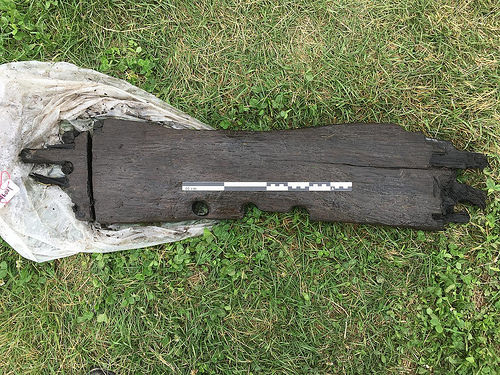
AARHUS UNIVERSITY—In 2014 archaeologists from the Museum of South East Denmark and Aarhus University discovered the previously unknown Viking fortess at Borgring south of Copenhagen. Since then the search has been on to uncover the life, function, destruction and, not least, the precise dating of the Viking fortress. Now a new find has produced a break-through in the investigation.
In the period 2016-18 a programme of new excavations is made possible by a grant from the A.P. Møller Foundation. The team from the Museum of South East Denmark and Aarhus University are joind by leading experts from the Environmental Archeology and Materials Research at the Danish National Museum and the National Police Department’s Section for arson investigation. Prior to this year’s excavations it was only known that the massive, 150m wide fortress dated to the tenth century. Experts suspected that it was built in the reing of Viking king Harold Bluetooth (c.958-c.987), but the association could not be proven.
On Monday 26 June, the archaeological team opened new trenches is the meadow next to the fortress to search for evidence of the landscape surrounding the fortress. Around 2.5 meters below the current surface of the valley was found a c. 1m long piece of carved oak wood with drilled holes and several wooden pegs in situ. The wood carries clear traces of wear, but it is not currently possible to say what function the wood piece has had.
Leading specialist in dendrochronological dating, Associate Professor Aoife Daly from the University of Copenhagen and the owner of dendro.dk, has just completed his study of the piece of wood and says: “The plank is oak and the conserved part of the tree trunk has grown in the years 829-950 In the Danish area. A comparison with the material from the Trelleborg fortress in Sjælland shows a high statistical correlation that confirms the dating. Since no splints have been preserved, it means that the tree has fallen at some point after year 966 “.
Research leader Jens Ulriksen says: “The wood piece was found on top of a peat layer, and is fully preserved as it is completely water-logged. We now have a date of wood in the valley of Borgring, which corresponds to the dating from the other ring fortresses from Harold Bluetooth’s reign. With the dendrochronological dating, in conjunction with the traces of wear the piece has, it is likely that the piece ended as waste in the late 900s, possibly in the early 1000’s. “
“In the coming week, the National Museum’s environmental archaeologists will take samples of wet depositions in the valley with the aim of uncovering how the layers have evolved from the earliest strata we have dated to the Bronze Age and over time.” Says excavation leader Nanna Holm. Nanna Holm, of course, hopes that the studies will particularly clarify one of the unclear questions archaeologists have, namely where the river was exactly when the fortress was built in the Viking Age, and how passable it was.
Søren M. Sindbæk, professor in Archaeology at Aarhus University and part of the excavation team says: “This find is the major break-through, which we have been searching for. We finally have the dating evidence at hand to prove that this is a late tenth century fortress. We lack the exact year, but since the find also shows us where the river flowed in the Viking Age, we also know where to look for more timbers from the fortress.”
__________________________________
The carved oak timber object recently found in peat layers just outside the south gateway of the fortress. The piece has been cut and sampled for dendrochronological sampling (left). The function of the piece is unknown, but it may be a part of a door or building. Credit: The Museum of South East Denmark / Nanna Holm.
_____________________________________________
Article Source: Aarhus University news release
_____________________________________________
Receive 30 days free access to the popular new CuriosityStream lineup of documentaries on science, history, nature, and technology as a new Popular Archaeology premium subscriber.
___________________________________________
Travel and learn with Far Horizons.
____________________________________________
This richly illustrated issue includes the following stories: Recent findings shedding new light on the whereabouts of the remains of Philip of Macedon, father of Alexander the Great; how an archaeologist-sculptor is bringing bones of the dead back to life; archaeologists uncovering town life at the dawn of civilization; an exclusive interview with internationally acclaimed archaeologist James M. Adovasio about what makes the Meadowcroft Rockshelter prominent in the ongoing search for the first Americans; what archaeologists are finding at the site of the ancient city of Gath, the home town of the biblical Philistine giant, Goliath; and how scientists are redrawing the picture of human evolution in Europe. Find it on Amazon.com.






